This Is How Whales Sleep Without Drowning— And It’s Not What You Think
The blue whale is the largest animal that has ever lived — bigger than any dinosaur, larger than any beast that ever walked the Earth. And naturally, that brings up a big question.
Do Whales Sleep?
Most of us never think about it. How does the largest animal on Earth go to sleep?
They don’t close their eyes and drift off like we do. They don’t curl up on a cozy reef or float dreamily on the surface. Whales must consciously breathe, meaning they can’t fully “switch off” the way humans or land mammals do.
And for a long time, scientists had no clear idea how these marine giants managed to rest without drowning. That changed in 2020.
How Do Whales Sleep Without Drowning?
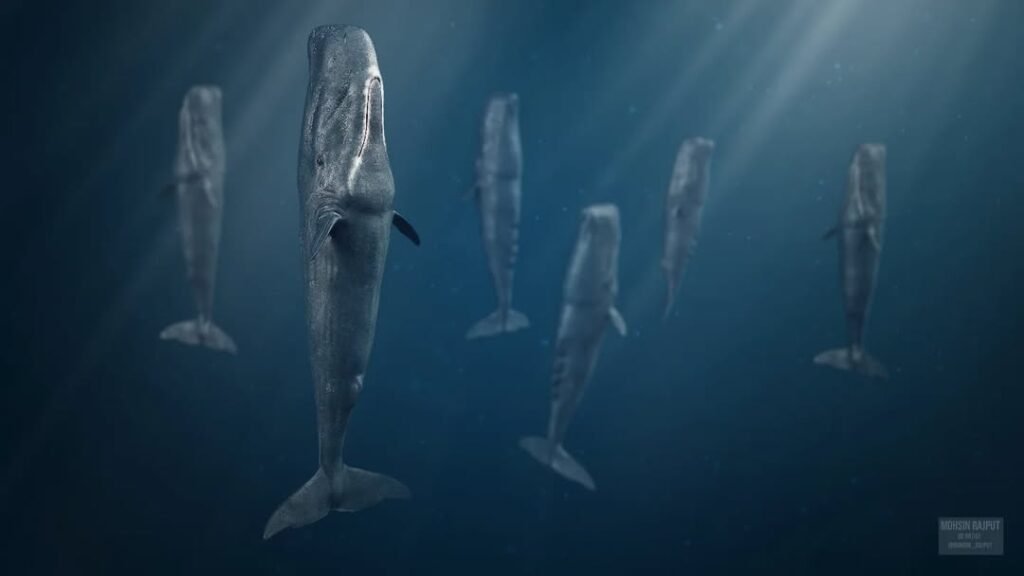
To survive, whales have evolved a beautiful adaptation:
They sleep by “turning off” one half of their brain to rest while the other half remains alert.
This sleep mode is called unihemispheric slow-wave sleep. One half of the brain sleeps, the other stays awake — alert enough to breathe, watch for danger, and surface if needed. Their eyes often close one at a time. It’s not deep unconsciousness — it’s a kind of half-dreaming survival.
Some whales drift slowly during this state. Others float motionless near the surface. But a few — like the sperm whale — do something even stranger.
In 2020, researchers found something astonishing: Sperm whales sleep vertically. Yes — vertically. Not horizontally, not curled up, not on the move — but standing still, nose up, tail down, like silent rockets waiting to launch. That’s how they nap.
They float this way in tight-knit groups, usually 5 or 6 individuals. They rest for 10 to 20 minutes at a time, suspended just below the surface. No motion. No noise. Just stillness. To witness it is to feel like you’ve stumbled upon something not quite real. They don’t look like animals anymore — they look like monuments.
Planets whose orbits have frozen. Time itself paused in the water.
It’s haunting. Beautiful. Surreal.
2023: When the World Finally Saw Sleeping Whales
Until recently, this surreal behavior was purely theoretical.
Then in 2023, French photographer Stéphane Granzotto was documenting sperm whales in the Mediterranean for a book — and found himself in the middle of a pod of sleeping whales.
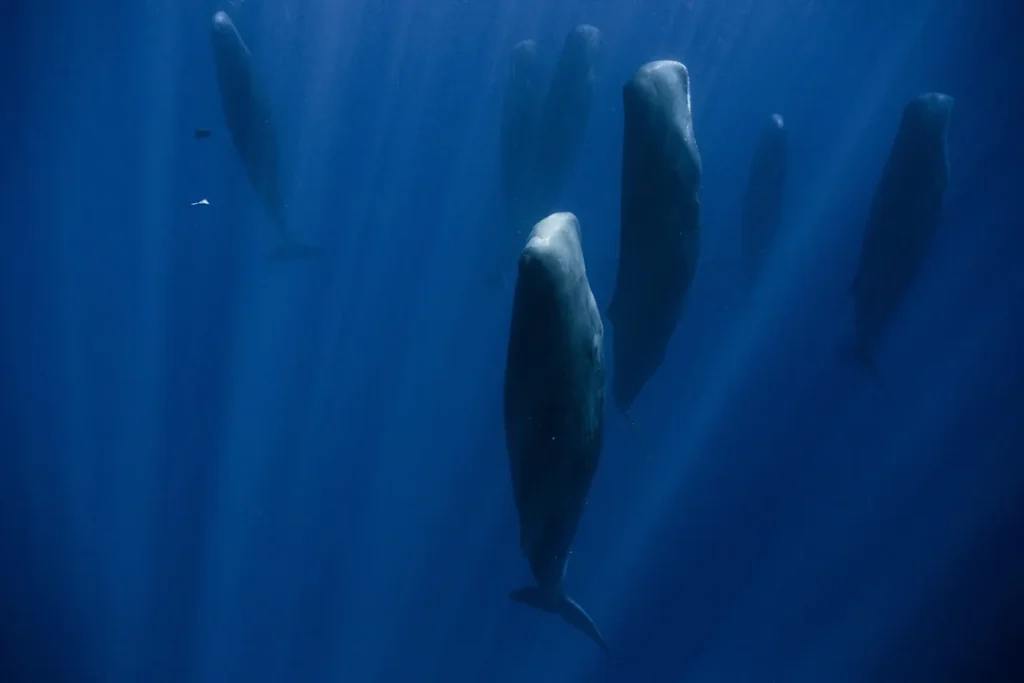
He captured what no one had before: the photographic proof of whale sleep in its raw, mystical form. The photos Granzotto captured quickly spread across marine biology circles — and then the world. They weren’t just technically perfect. They were emotionally striking, revealing something we didn’t even know we needed to see..
Why Do Whales Sleep Vertically?
It’s still partly a mystery. But scientists believe this vertical sleeping position may help them:
- Maintain spatial awareness while floating motionless
- Detect predators or environmental changes with one half of the brain still semi-alert
- Rest the body without sinking too deep or floating to the surface
- Whales are unihemispheric sleepers, meaning they rest one hemisphere of their brain at a time, allowing them to continue conscious breathing and awareness even while napping.
The vertical pose? It might just be the perfect balance between rest and survival.
Do Other Whale Species Sleep This Way?
Sperm whales are currently the best-documented example of vertical sleep, but similar behavior has been observed — albeit less formally — in,
Beluga whales
Pilot whales
Some species of dolphins
Still, it’s sperm whales that show this behavior most dramatically — gathering in tranquil pods, nose-up in the water, resting like drifting monoliths from a dream.
How Long Can Whales Hold Their Breath Underwater?
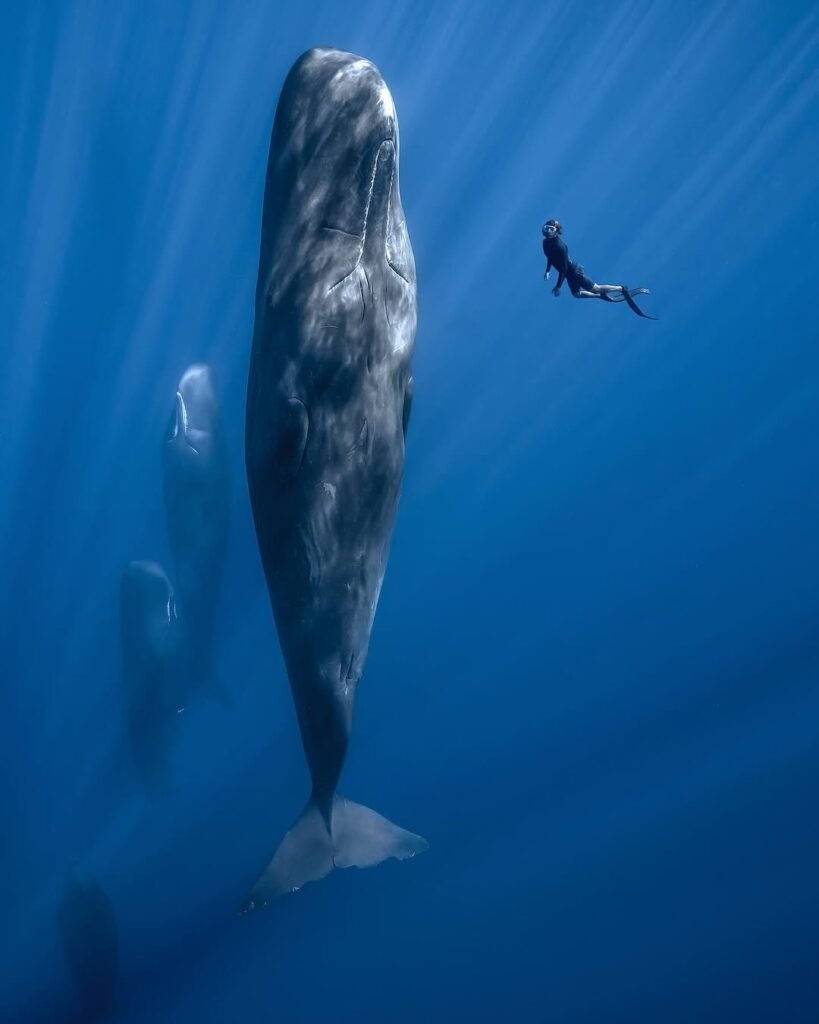
Depending on the species, whales can hold their breath anywhere from 45 minutes to over two hours before needing to surface. Sperm whales, for example, are known to dive for extended periods, disappearing into the deep like ghost ships.
So how do they do it?
Whales don’t just breathe deeply — they breathe differently.
Each breath they take is more oxygen-rich than ours. Their lungs compress to avoid nitrogen issues during deep dives. Their red blood cells are specially adapted to carry significantly more oxygen per volume than human blood. And once submerged, they use that oxygen wisely.
Whales slow their heart rate, sometimes to just a few beats per minute. They redirect blood flow away from the surface of their body and toward vital organs — like the brain, heart, and swimming muscles — conserving every molecule of oxygen for survival.
It’s not just a breath.
It’s a biological strategy, perfected over millions of years, that allows these giants to vanish into the blue… and stay there.
Before the Water, They Walked
Blue whales weren’t always ocean giants.
Their ancestors were land mammals, small, strange creatures like pakicetus — think possum-headed swamp dogs sewn together by evolution’s weirdest stitch.
Over millions of years, those awkward mammals slid back into the water.
They became dorudon, 4.5 meters long, with flippers and tails that beat up and down like modern whales. Then they kept growing. And growing.
Now they eat trillions of krill, exhaling through blowholes with thunderous force. And somewhere between the krill and the cosmos, they stop. They sleep. And the sea holds them.
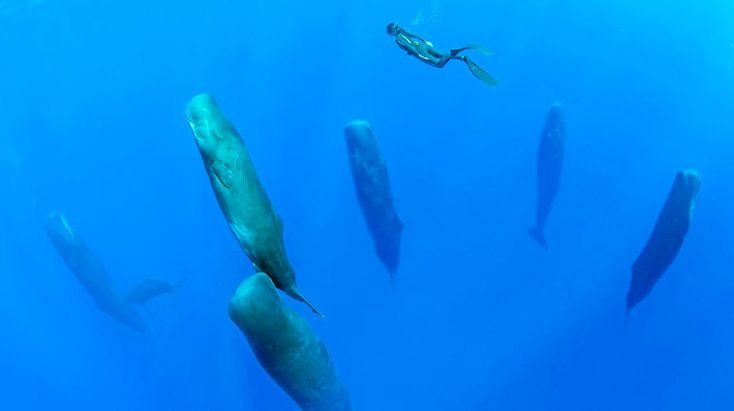
Poet David Baker once wrote:
“Weeks I couldn’t sleep. Years I couldn’t waken.”
His poem, Whale Fall, refers to what happens when a whale dies. Its body sinks to the ocean floor, becoming an entire ecosystem — a galaxy of life that can last over a century.
But long before that fall, comes the rest. The living whale doesn’t rest on the seafloor. It rests on nothing. On stillness. On silence. On faith.
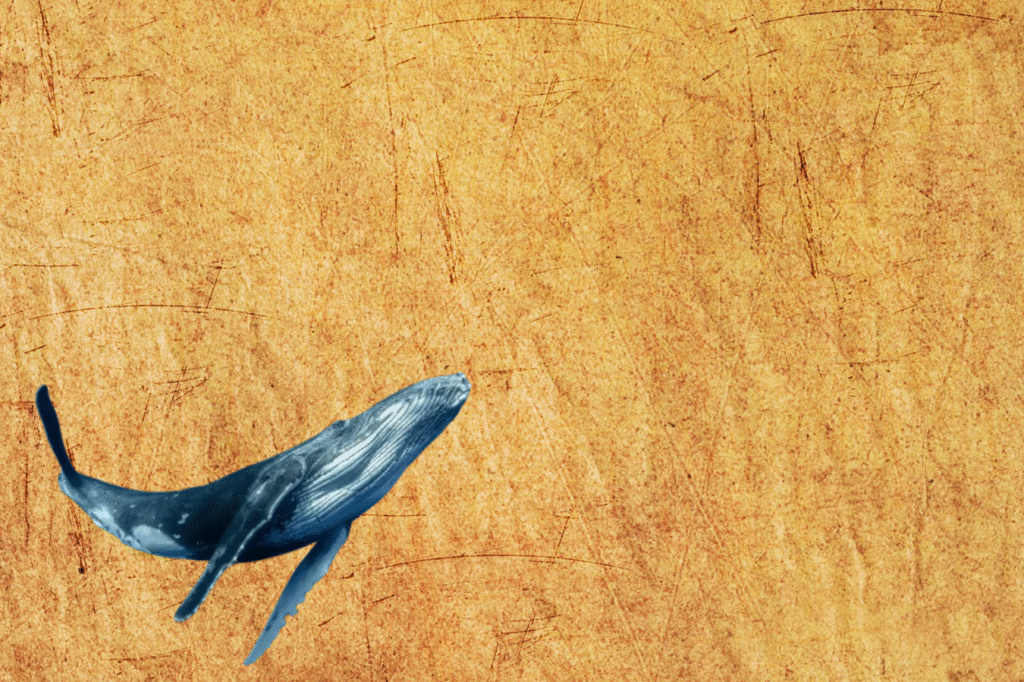
Did You Know?
Blue whales have hearts the size of small cars, weighing nearly 400 pounds, and beating as slowly as two times per minute during a dive. Their tongues weigh more than a full-grown elephant, and their babies gain up to 200 pounds a day while drinking 50 gallons of milk. Some species, like sperm whales, can hold their breath for more than two hours, thanks to blood cells that carry more oxygen than ours, and lungs that fill almost completely with a single, massive breath. Whales sleep with one eye open, literally—shutting down only half their brain at a time so they can rest and breathe without drowning. They sing songs that travel across entire oceans, hunt with spirals of bubbles like underwater choreographers, and release nutrient-rich waste that feeds phytoplankton—the tiny ocean plants that help regulate Earth’s climate. Oh, and the sperm whale? It has the largest brain of any animal on the planet. These aren’t just creatures of the sea. They’re ancient, breathing marvels of biology, evolution, and wonder.



